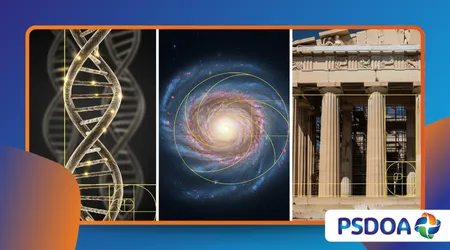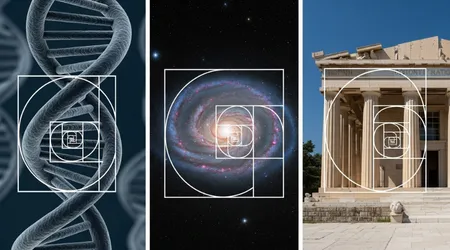La proporción áurea en el ADN, las galaxias y la arquitectura

La proporción áurea en el ADN, las galaxias y la arquitectura Es una idea cautivadora y persistente. Sugiere un modelo universal para la belleza y la vida.
Anuncios
Este número, $\phi$ ($1.618…$), parece aparecer en todas partes. Lo vemos en el arte, la naturaleza y el cosmos profundo.
¿O no? Esta columna explora la delgada y fascinante línea que separa la verdad matemática de la mitología humana.
Debemos investigar las afirmaciones sobre esta «proporción divina». También debemos distinguir entre la ciencia verificable y la pareidolia humana. ¿Es esta proporción un verdadero código cósmico? ¿O es simplemente una hermosa y fascinante coincidencia?
¿Qué es exactamente la proporción áurea?
Este famoso número, conocido como $\phi$ (phi), es matemáticamente único.
Anuncios
Es un número irracional, aproximadamente $1.6180339…$. Los antiguos griegos, incluido Euclides, definieron por primera vez sus propiedades geométricas. Se obtiene dividiendo una línea en dos partes desiguales.
La línea completa (A+B) dividida por la parte más larga (A) debe ser igual a la parte más larga (A) dividida por la parte más corta (B).
Esto crea la ecuación (A+B)/A = A/B = $\phi$. Esta proporción está intrínsecamente ligada a la secuencia de Fibonacci (1, 1, 2, 3, 5, 8, 13…). Al dividir números sucesivos (por ejemplo, $13/8$), el resultado se aproxima a $\phi$.
Esta profunda elegancia matemática ha inspirado a los místicos durante siglos. Se siente como un componente fundamental de la realidad.
¿Por qué nos fascina tanto este número?

Los seres humanos estamos programados para encontrar patrones significativos en el caos. La proporción áurea parece ofrecer un estándar universal y objetivo de belleza y armonía. Nos sentimos psicológicamente atraídos por el equilibrio y la proporción coherente.
Un estudio realizado en 1876 por el psicólogo alemán Gustav Fechner sugirió esta preferencia. Descubrió que las personas tendían a preferir los rectángulos más cercanos a la forma “áurea”.
Esta idea de una forma «ideal» es estéticamente poderosa. Proporciona un puente entre las matemáticas abstractas y la belleza tangible.
++ Observatorios de neutrinos: escuchando las partículas fantasma del universo
¿Esta preferencia es real o imaginaria?
¿Esta preferencia resiste un análisis crítico en 2025? Estudios recientes, como los de la Escuela Haas de la UC Berkeley, son mucho menos concluyentes. Estos estudios hallaron que las preferencias varían ampliamente según el contexto cultural.
La fascinación por el La proporción áurea en el ADN, las galaxias y la arquitectura puede decir más sobre a nosotros que sobre el universo.
Es una forma de sesgo de confirmación matemática. Buscamos el patrón, así que lo encontramos en todas partes, incluso cuando no encaja a la perfección.
Lea también: El misterio de la sonoluminiscencia: cuando el sonido crea luz
La analogía de las nubes
Esta tendencia humana a percibir patrones se llama pareidolia. Es el mismo impulso psicológico que nos hace ver una cara en las nubes o una figura humana en la luna. Estamos programados para encontrar rostros, por eso los vemos.
Nos fascina la relación 1TP⁴T\phi1TP⁴T, por lo que la buscamos. Si trazas suficientes líneas sobre cualquier objeto complejo —un edificio, un rostro, una galaxia—, eventualmente encontrarás proporciones que se aproximan a 1TP⁴T1,6181TP⁴T.
Esto no implica un plan divino; solo demuestra que los sistemas complejos contienen matemáticas complejas.
Leer más: La extraña física de los cristales del tiempo
¿Cómo se comporta la proporción áurea en el ADN, las galaxias y la arquitectura ante un análisis crítico?
Aquí es donde la grandiosa y romántica teoría se topa con la dura y cuantificable realidad de la ciencia. Las afirmaciones son amplias y contundentes, pero la evidencia verificable suele ser escasa o inexistente.
Debemos aplicar un escepticismo periodístico riguroso a estas ideas populares. Analicemos uno por uno los tres ejemplos más famosos.
¿Aparece la proporción áurea en la arquitectura antigua?
Esta es la afirmación más famosa, que cita el Partenón de Atenas. Se alega que la fachada del templo encaja perfectamente dentro de un rectángulo áureo. Este es el ejemplo «clásico» que utilizan sus defensores para probar la sabiduría antigua.
Sin embargo, las mediciones verificables no respaldan esta afirmación. Un análisis detallado de 2015 realizado por el investigador de $\phi$, George Meisner, confirma que las dimensiones del Partenón no se corresponden exactamente con $\phi$.
Es necesario trazar muchas líneas arbitrariamente en las fotografías para forzar el ajuste. No existe ninguna evidencia histórica de que los griegos (como Fidias) siquiera conocieran, y mucho menos utilizaran, el sistema $\phi$.
¿Y qué hay de arquitectos modernos como Le Corbusier?
Aquí, la evidencia es innegable, ya que fue intencional. El arquitecto del siglo XX Le Corbusier explícitamente Utilizó la proporción áurea. Desarrolló un sistema detallado llamado “Le Modulor” en la década de 1940.
Su Unité d'Habitation en Marsella, Francia, es un claro ejemplo. Su fachada, paneles y distribución interior utilizan proporciones Modulor.
Le Corbusier creía que esto creaba espacios «armoniosos» centrados en el ser humano. Por lo tanto, $\phi$ existe en la arquitectura, pero generalmente solo cuando deliberadamente colocado allí por el diseñador.
¿Se encuentra la proporción áurea en las galaxias espirales?
Esta afirmación se centra en la impresionante belleza de las galaxias espirales. Muchas, como M51 (la Galaxia Remolino), parecen ser espirales doradas perfectas. Una espiral dorada tiene un ángulo de inclinación específico y constante de aproximadamente 17,031 grados.
El problema es que las galaxias reales no se ajustan a esta descripción. Las galaxias espirales, de hecho, sí lo hacen. espirales logarítmicas, una categoría más amplia.
Pero sus ángulos de inclinación específicos varían ampliamente, de 10 a 40 grados. Muy pocos, si acaso alguno, coinciden exactamente con la espiral dorada.
La afirmación de que La proporción áurea en el ADN, las galaxias y la arquitectura Lo que se aplica al cosmos es un caso clásico de aproximación estética, no de astrofísica.
¿Está realmente la proporción áurea en nuestro ADN?
Esta es quizás la afirmación más convincente y debatida científicamente. El argumento se centra en la estructura de doble hélice del ADN.
Vista desde arriba, la sección transversal de la hélice (un decágono) se basa intrínsecamente en la geometría $\phi$.
Además, se citan las dimensiones de la hélice como prueba. Una vuelta completa de la hélice mide 34 angstroms de longitud.
El ancho de la hélice es de aproximadamente 21 angstroms. Estos dos números (21, 34) son consecutivos en la sucesión de Fibonacci. Su cociente (1TP⁴T34/21 ≈ 1,6191TP⁴T) es una aproximación notablemente precisa de 1TP⁴Tφ1TP⁴T.
Esta relación numérica es sorprendente y ha sido documentada científicamente. Investigadores como Jean-Claude Perez han publicado artículos sobre este mismo tema.
Argumentan que esta estructura basada en $\phi$ proporciona la máxima eficiencia y estabilidad para el ADN. La proporción áurea en el ADN, las galaxias y la arquitectura Encuentra aquí su fundamento más sólido y plausible.
¿Pero se trata de física fundamental o de una profunda coincidencia? Muchos biólogos convencionales siguen siendo escépticos y lo califican de numerología.
Argumentan correctamente que los valores de angstrom son promedios, no constantes rígidas. Esto sigue siendo un descubrimiento verdaderamente inusual, que se encuentra al margen del consenso científico. Es una pista tentadora que aún no está completamente demostrada.
¿Qué es la ciencia real frente al mito? (La gran desconexión)
Debemos separar las matemáticas reales de su aplicación mística.
La idea de la La proporción áurea en el ADN, las galaxias y la arquitectura Es una idea que suele ser más romántica que universalmente cierta. Es una historia seductora que nosotros desear Para ser sincero.
El universo es hermoso sin necesidad de un “número mágico” que lo rija todo. La verdadera ciencia de la biología, la cosmología y la física es mucho más compleja y sutil.
No se rige por una única proporción estética, sino por una sinfonía de leyes interrelacionadas.
| Dominio reclamado | La afirmación popular | El consenso científico (2025) |
| Arquitectura antigua | El Partenón y las Pirámides se construyeron utilizando $\phi$. | Desmentido. Las medidas no coinciden. Un mito que surgió en el siglo XIX. |
| Arquitectura moderna | Le Corbusier utilizó $\phi$ en sus diseños. | Hecho. Lo utilizó explícitamente en su Modulador sistema. |
| Galaxias espirales | Las espirales galácticas coinciden con la Espiral Dorada. | Mayormente falso. Las galaxias son espirales logarítmicas, pero con ángulos variables. |
| ADN humano | La doble hélice ($34\r{A} \times 21\r{A}$) coincide con $\phi$. | Debatido. La proporción es sorprendentemente similar, pero la causalidad no está demostrada. |
Fuente: Compilado a partir de revistas científicas y teoría arquitectónica (2025).
Por qué debemos permanecer escépticos
Como periodista, debo priorizar la evidencia verificable sobre la preferencia estética. La idea de un código secreto entretejido en la realidad es atractiva, pero puede alejarnos de la ciencia rigurosa y acercarnos a un simple misticismo.
El La proporción áurea en el ADN, las galaxias y la arquitectura Es una historia seductora.
Pero a menudo, no es más que eso: una historia. Debemos tener cuidado de no imponer nuestra concepción humana de la belleza a las leyes fundamentales, y a menudo no intuitivas, del cosmos.
Ejemplo fascinante
La mano humana. Se suele afirmar que las falanges (segmentos óseos) de nuestros dedos guardan proporción con la proporción áurea. Esta afirmación es fácil de comprobar. Basta con medir la propia mano.
Observarás que las proporciones varían drásticamente de persona a persona. Rara vez, o nunca, se aproximan exactamente a un promedio de $1,618$.
Esta es la metáfora perfecta para todo el mito: parece plausible a simple vista, pero falla al examinarlo de cerca y con ojo crítico. Es un ideal impuesto a una realidad variada e imperfecta.
Conclusión: La compleja sinfonía del universo
La búsqueda de La proporción áurea en el ADN, las galaxias y la arquitectura En última instancia, es una cuestión profundamente humana.
Refleja nuestro profundo deseo de un orden universal y una conexión entre nuestra conciencia y el cosmos. desear el universo para compartir nuestro sentido de la belleza.
Sin embargo, la evidencia revela una verdad más compleja y matizada. La proporción está presente en la arquitectura cuando los diseñadores la colocan allí intencionalmente.
Su presencia en las galaxias es un bello caso de identidad errónea. Su aparición en el ADN sigue siendo la pista más convincente, aunque también la más debatida.
La proporción áurea es una maravilla matemática, pero no es el modelo único y universal de toda la realidad. El universo se rige por una sinfonía de leyes, no por una sola nota perfecta.
¿Has encontrado ejemplos concretos de $\phi$ en tu propia vida, o lo consideras un mito? ¡Comparte tus hallazgos y experiencias en los comentarios a continuación!
Preguntas frecuentes
¿Cuál es la diferencia entre la proporción áurea y la regla de los tercios?
La regla de los tercios es una guía de composición en fotografía. Divide el encuadre en nueve cuadrados iguales, sugiriendo colocar los sujetos en las intersecciones.
Es una aproximación simplificada de la proporción áurea, pero matemáticamente no es lo mismo.
¿Utilizaron la proporción áurea artistas de la antigüedad como Leonardo da Vinci?
Este tema es objeto de intenso debate, al igual que el Partenón. Da Vinci estudió profundamente las proporciones humanas (véase El hombre de Vitruvio).
Sin embargo, no hay pruebas directas de que él conscientemente aplicó $\phi$ al Mona LisaEstas afirmaciones se aplicaron mayoritariamente de forma retroactiva, siglos después de su muerte.
¿Está la proporción áurea relacionada con la secuencia de Fibonacci?
Sí, están intrínsecamente ligados. A medida que divides números sucesivos en la secuencia de Fibonacci (por ejemplo, 5/3, 8/5, 13/8, 21/13…), el número resultante se acerca cada vez más a $1.618…$ ($\phi$).
¿Por qué algunos científicos siguen investigando la proporción áurea en el ADN, las galaxias y la arquitectura?
Porque el vínculo entre las matemáticas y el mundo físico es real y profundo. Si bien muchas afirmaciones son falsas, la conexión con el ADN sigue siendo fascinante.
La ciencia debe investigar las anomalías, incluso si parecen místicas. El objetivo es encontrar principios físicos reales, no meras coincidencias.
